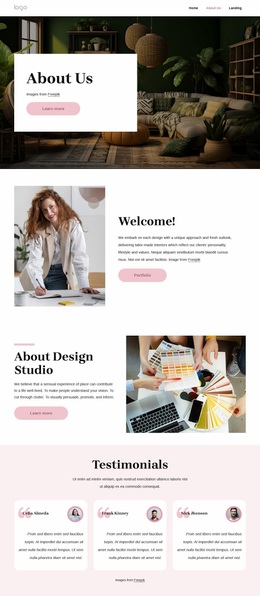The Ultimate Guide to Modern Internet Site Design Trends
In the ever-evolving digital landscape, contemporary internet site layout trends play an important role in forming individual experience and engagement. From the increase of minimal design principles that prioritize simpleness to the impact of vibrant typography in defining brand name identification, each component contributes to a cohesive on the internet presence.
Minimalist Style Principles
Minimalist design concepts emphasize the concept that much less is more, supporting for simplicity and functionality in aesthetic communication. This approach strips away unneeded aspects, concentrating instead on crucial parts that share the intended message efficiently. By focusing on clarity, minimal style enhances customer experience, enabling visitors to navigate sites effortlessly.
Core tenets of minimal layout consist of using enough white area, which produces a sense of balance and organization. This negative room not only directs the visitor's focus to crucial elements but also cultivates a calming aesthetic ambience. Furthermore, a restricted shade palette is usually utilized, making use of single systems or soft hues to maintain aesthetic communication and protect against frustrating the user.
Typography plays a critical role in minimal style, where readable font styles are picked for their simpleness and effectiveness in communicating material. Eventually, minimal layout principles cultivate a concentrated environment that encourages users to engage with the web content, improving the overall effectiveness of modern web site design.
Vibrant Typography Options
Accepting strong typography options has come to be a defining attribute of contemporary site style, as it properly records interest and shares strong messaging. Designers are progressively using typography not merely as a functional component but as an essential aesthetic component that boosts the overall aesthetic and customer experience.

In addition, the association of bold typography with minimalist design concepts enables striking contrasts, boosting readability while keeping aesthetic appeal. Using whitespace around vibrant text better stresses its significance, ensuring that the message reverberates with the audience.
As electronic landscapes come to be much more competitive, leveraging strong typography allows brands to differentiate themselves and leave an enduring perception. The mindful choice of font styles and their application can evoke emotions, establish tone, and drive action, making vibrant typography an essential tool in contemporary internet site layout. Ultimately, it is an effective means to enhance narration and guarantee that essential messages are not just seen but likewise felt.
Mobile-first and responsive Style
Responsive and mobile-first style has become a critical principle in modern website growth, reflecting the enhancing dependence on mobile tools for accessing on the internet content. As customer habits shifts towards mobile browsing, developers need to prioritize creating experiences that adjust perfectly across different display sizes and resolutions.
A receptive design makes sure that a site immediately readjusts its layout, images, and performance based on the gadget being utilized. Mobile-first design supporters for establishing sites initially for smaller displays, consequently scaling up to larger displays.
Carrying out receptive and mobile-first principles not only accommodates customer choices however you can check here also straightens with seo (SEO) practices. Major online search engine, like Google, prioritize mobile-friendly internet sites in their rankings, making it critical for services to embrace these design approaches. In an affordable digital landscape, embracing receptive and mobile-first design is get redirected here not just an option; it is vital for making certain accessibility and engagement with a varied audience.
Involving Microinteractions
Microinteractions play a pivotal role in boosting customer interaction and total website experience, particularly in the context of mobile-first and receptive design. These subtle layout components provide prompt comments to users, making communications extra enjoyable and instinctive. Instances include button animations, alert signals, and loading indications, which not only overview individuals however also produce a feeling of link with the interface.
Including interesting microinteractions can substantially enhance usability by lowering cognitive lots. When individuals receive visual or acoustic comments upon doing actions, such as clicking a button or sending a form, they feel extra positive in their choices. This fosters a smoother navigation experience, inevitably enhancing user retention.

As site layout trends remain to develop, the value of microinteractions can not be overemphasized. They this serve as the subtle yet effective touchpoints that change normal interactions into remarkable experiences, consequently raising the general efficiency of modern website design.
Lasting Website Design Practices
Lasting website design practices are ending up being progressively necessary as the electronic landscape expands and environmental problems rise. Developers and developers are recognizing their responsibility to create websites that not only serve individual needs but likewise reduce ecological impact. This method encompasses numerous crucial approaches.
To start with, optimizing energy consumption is extremely important. Sites should be designed to pack rapidly and effectively, which lowers web server energy usage and boosts customer experience. Methods such as picture compression, decreasing HTTP demands, and making use of modern coding practices add dramatically to this goal.
Secondly, choosing eco-friendly hosting companies is essential - website design. Lots of holding business are currently powered by renewable energy sources, making it possible for websites to operate in a more lasting way. This option mirrors a dedication to lowering carbon footprints
Furthermore, adopting a minimal layout can boost sustainability. Fewer components on a web page bring about less information transfer, which not just quickens loading times yet likewise saves resources.
Last but not least, promoting digital availability ensures that sites reach a larger target market without unneeded bloat, aligning user experience with ecological obligation. By integrating these sustainable techniques, web designers can contribute positively to both user involvement and the earth's health.
Verdict
In recap, contemporary web site design fads highlight the combination of minimal principles, vibrant typography, and responsive design to improve individual experience. Engaging microinteractions contribute to unforgettable communications, while lasting techniques advocate for environmentally mindful growth. Collectively, these components not only boost visual charm yet additionally boost capability, guaranteeing that websites are both easy to use and aesthetically striking. Taking on these fads is necessary for developing impactful electronic experiences that resonate with customers in a progressively competitive online landscape.
In the ever-evolving electronic landscape, modern-day web site design patterns play a crucial duty in shaping user experience and engagement. By prioritizing quality, minimalist design improves user experience, permitting visitors to browse sites effortlessly.
Ultimately, minimal style concepts cultivate a concentrated environment that urges individuals to engage with the web content, improving the general efficiency of modern-day internet site style.Microinteractions play a pivotal duty in improving individual interaction and general web site experience, especially in the context of mobile-first and receptive style.In summary, contemporary website design patterns emphasize the combination of minimalist principles, bold typography, and receptive style to boost customer experience.